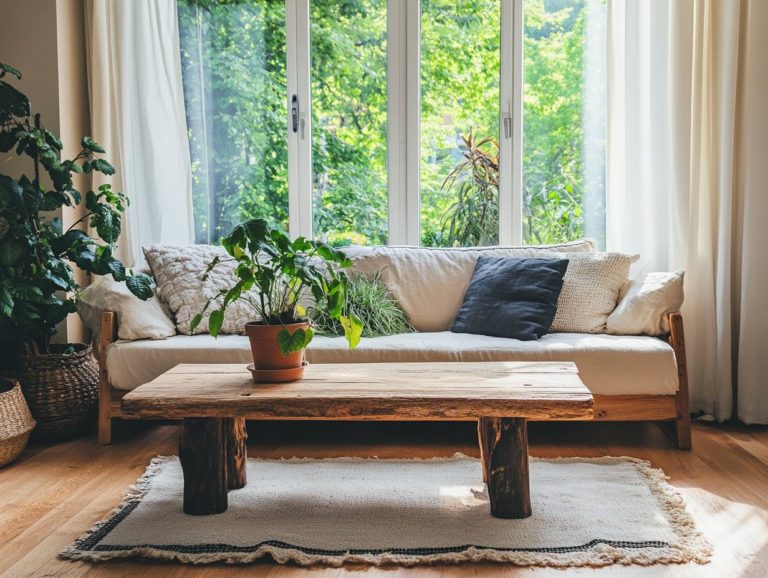Eco-Conscious Home: Sustainable Material Choices
In today s world, the urgency for sustainability is more important than ever, particularly in home construction. As you strive to minimize your environmental footprint, opting for eco-friendly materials not only benefits the planet but also elevates the quality and efficiency of your living spaces.
This article delves into a variety of sustainable material options, carefully weighing their advantages and disadvantages. You’ll find practical tips on how to seamlessly integrate these materials into your home design.
We will also share valuable insights on maintaining eco-conscious choices for long-term sustainability.
Discover how to make your home a stunning showcase of sustainability!
Contents
- Key Takeaways:
- The Importance of Sustainable Materials in Home Construction
- Eco-Friendly Material Options
- Types of Sustainable Materials
- Benefits and Drawbacks of Each Material
- Factors to Consider When Choosing Sustainable Materials
- Cost, Availability, and Durability
- Implementing Sustainable Materials in Home Design
- Maintaining and Caring for Sustainable Materials
- Frequently Asked Questions
- What does it mean to have an eco-conscious home?
- Why is it important to make sustainable material choices for your home?
- What are some examples of sustainable materials?
- How do I know if a material is truly sustainable?
- Are sustainable materials more expensive than traditional materials?
- Can I still have a stylish and modern home with sustainable materials?
Key Takeaways:

- Choosing sustainable materials transforms your home construction into a powerful eco-friendly statement.
- Eco-friendly materials such as bamboo, recycled plastic, and reclaimed wood offer numerous benefits, though they may present challenges regarding cost and availability.
- When selecting sustainable materials, consider factors like cost, availability, and durability, and incorporate them into various areas of your home for a balanced eco-conscious design.
The Importance of Sustainable Materials in Home Construction
The significance of sustainable materials in home construction cannot be overstated. These materials are vital for promoting energy conservation, improving air quality, and reducing environmental impact.
In a world that’s increasingly attentive to climate change, opting for materials that prioritize ecological integrity, like reclaimed wood, bamboo, and straw bale, supports effective green building practices while resonating with your vision for an eco-friendly home. Understanding why sustainable materials matter in home design can further enhance your commitment to sustainability.
Incorporating innovative materials such as hempcrete and smart glass can greatly enhance the sustainability of your residential structure. For a deeper understanding, explore the impact of sustainable materials on home design. These choices position your home as a beacon of modern eco-conscious living.
Why Choose Eco-Friendly Materials?
Choosing eco-friendly materials is essential in your journey toward sustainable living. These materials not only aid in energy conservation but also elevate the overall health of your home environment.
By selecting options like living roofs and VOC-free paint, you can significantly reduce your ecological footprint while fostering a healthier lifestyle.
Embracing these sustainable choices brings remarkable health benefits, as many eco-friendly materials are free of harmful chemicals that can worsen indoor air pollution. The financial advantages are compelling; while the initial investment might be higher, the long-term savings on energy bills and maintenance can be substantial.
As the trend of green building continues to gain traction, property values in eco-friendly neighborhoods tend to rise, making it a smart investment. By prioritizing ecological solutions, you protect your well-being and contribute to a vibrant, sustainable future for generations to come.
Eco-Friendly Material Options
The range of eco-friendly material options available today is impressive, showcasing a variety of sustainable and natural building materials that meet diverse aesthetic and functional needs in contemporary construction.
Materials such as rammed earth, bamboo, hempcrete, and wool insulation champion energy conservation and uphold the principles of green building. Embracing these choices allows you to create spaces that are both beautiful and environmentally responsible.
Start your journey towards a greener home today!
Types of Sustainable Materials

Discover a treasure trove of sustainable materials just waiting for your project! Each material boasts unique properties that enhance energy conservation and promote environmental sustainability in building practices.
Take rammed earth, straw bale, and bamboo, for instance. These materials are celebrated for their impressive natural insulation capabilities.
On the cutting edge, you have options like solar tiles and structural insulated panels (insulated panels that provide energy efficiency), which offer innovative solutions for optimizing energy efficiency.
As you explore these alternatives, uncover their myriad advantages over traditional materials. Rammed earth not only has a low carbon footprint but also excels in heat retention, effectively regulating indoor temperatures.
Straw bale is often underestimated; it delivers exceptional insulation values without breaking the bank compared to standard options. Let s not forget bamboo its rapid growth rate makes it a remarkably renewable resource.
Modern technologies, like solar tiles, enable you to harness natural energy straight from your rooftop, drastically reducing reliance on fossil fuels. Case studies illustrate how these materials perform across diverse climates and building types, showcasing real-world applications that align perfectly with eco-conscious building standards.
Benefits and Drawbacks of Each Material
Every sustainable material comes with its own set of benefits and drawbacks. You must carefully evaluate your options based on factors like cost, availability, and durability.
Take reclaimed wood: it offers that charming aesthetic and sustainability but can be hard to find. On the flip side, materials like recycled steel are durable but may strain your budget upfront.
Bamboo stands out as a compelling alternative due to its fast growth and renewability, making it a go-to choice in eco-friendly construction. However, its vulnerability to moisture could be a concern in certain climates.
Conversely, hemp-based products are praised for their excellent insulation properties and minimal environmental impact. Still, processing costs can hinder broader adoption.
By analyzing case studies from various projects, it becomes clear that selecting sustainable materials often requires balancing environmental integrity and practical constraints. Each option brings unique financial and logistical considerations, demanding a thoughtful assessment on your part.
Factors to Consider When Choosing Sustainable Materials
When selecting sustainable materials for construction, consider several key factors to ensure your choices align with your project goals and their environmental impact.
The cost of sustainable materials can vary significantly. Understanding their availability and durability is crucial in the broader context of energy conservation and sustainable building practices.
Cost, Availability, and Durability
Understanding cost, availability, and durability is essential when selecting building materials, especially in eco-friendly homes. These factors can significantly influence your design choices and long-term sustainability.
Consider material sourcing, market demand, and regional availability, as they play a crucial role in determining the feasibility of specific sustainable materials.
When evaluating cost, look beyond the initial price tag. Think about the long-term savings you can achieve through energy efficiency and reduced maintenance. Recent studies suggest that opting for sustainable materials like bamboo or reclaimed wood can lead to savings of up to 30% over a building s lifecycle.
Availability can also affect your project s timeline. Sourcing local materials often minimizes transport costs and reduces carbon footprints, while procurement delays can hinder progress.
Durability is equally important. High-quality materials manage wear and tear better, resulting in fewer replacements and less waste a fundamental principle of sustainable construction.
By carefully weighing these factors, you can make informed decisions that align with your budget and ecological aspirations.
Implementing Sustainable Materials in Home Design

Implementing sustainable materials in your home design is crucial for crafting spaces that are not only environmentally friendly but also visually stunning and highly functional.
By incorporating elements like living roofs, solar tiles, and biocomposites into your architectural plans, you can enhance the sustainability of your home. This approach allows you to address contemporary design challenges with creativity and flair.
Incorporating Eco-Friendly Materials into Different Areas of the Home
Incorporating eco-friendly materials into various areas of your home elevates sustainability and enhances modern design aesthetics, as detailed in our guide for homeowners.
Imagine wool insulation providing energy-efficient thermal performance; or reclaimed wood delivering a charming rustic finish. Each material plays a vital role in the grand tapestry of sustainable building.
You can see this thoughtful integration in kitchens featuring bamboo cabinetry, which exudes elegance and has a significantly lower environmental impact compared to traditional options.
In your living room, choosing organic fabrics and paints that release fewer harmful chemicals into the air fosters a healthier atmosphere while adding a touch of sophistication.
For the exterior, consider the benefits of recycled brick and solar panels. They seamlessly combine functionality with eco-consciousness.
To truly maximize these materials, seek out locally sourced products or certified sustainable options. This ensures your contributions to a greener planet are both impactful and stylish.
Maintaining and Caring for Sustainable Materials
Maintaining and caring for sustainable materials is essential for preserving their integrity. This practice ensures the longevity of eco-friendly homes and supports energy conservation, promoting optimal air quality.
By implementing regular maintenance practices tailored to each specific material, you can enhance their durability and functionality. This ensures they continue to perform effectively in their sustainable roles.
Tips for Long-Term Sustainability
Ensuring long-term sustainability in your eco-friendly home requires routine maintenance and proactive strategies.
Regular inspections, timely repairs, and the use of environmentally safe cleaning products can significantly enhance the longevity and performance of sustainable materials.
Think about implementing energy-efficient appliances. Changing HVAC filters regularly promotes better air quality in your home.
Simple measures, like sealing gaps around windows and doors, can effectively eliminate drafts, leading to reduced energy costs.
Consider landscaping with native plants. This not only conserves water but also supports local ecosystems.
Utilizing natural light through skylights or strategically placed mirrors can help decrease your reliance on artificial lighting.
Participating in community recycling programs improves waste management practices. It illustrates that sustainability extends beyond individual efforts and thrives as a collective responsibility.
Frequently Asked Questions

What does it mean to have an eco-conscious home?
An eco-conscious home is designed and built with sustainability and environmental impact in mind. This means choosing exciting sustainable materials and learning how to research sustainable materials for your home, implementing energy-efficient systems, and following eco-friendly practices.
Why is it important to make sustainable material choices for your home?
Making sustainable material choices for your home is crucial because it reduces your environmental impact. This also promotes a healthier and more efficient living space.
Sustainable materials are often made from renewable resources and have a lower carbon footprint, making them a better choice for the planet.
What are some examples of sustainable materials?
Examples of sustainable materials for your home include bamboo flooring, recycled glass countertops, reclaimed wood furniture, and energy-efficient appliances.
Other options include natural materials like cork, hemp, and wool.
Explore sustainable materials further and consider joining community efforts to promote eco-friendly living.
How do I know if a material is truly sustainable?
When researching materials for your home, seek certifications like LEED or Energy Star. They confirm that materials meet strict sustainability standards.
Are sustainable materials more expensive than traditional materials?
Generally, sustainable materials might cost more upfront. However, they often last longer and can save you money over time.
The cost of sustainable materials is dropping as they gain popularity.
Can I still have a stylish and modern home with sustainable materials?
Yes, definitely! There are many stylish options for sustainable materials that suit any design.
You can have sleek bamboo flooring or chic recycled glass countertops. Create a beautiful and eco-conscious home without sacrificing style!






